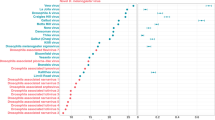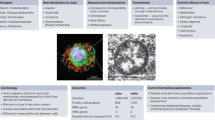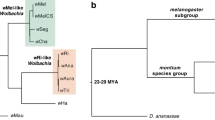Abstract
Microbes of the genus Wolbachia are transmitted by their hosts via the maternal parent and are responsible for cytoplasmic incompatibility among insect populations. This phenomenon can result in Wolbachia spreading through natural populations as previously demonstrated in Drosophila simulans. Here we describe another Wolbachia infection in D. simulans that does not cause cytoplasmic incompatibility. This is a property of the Wolbachia rather than the nuclear background. The infection occurs at a low frequency in natural populations from eastern Australia. The infection shows perfect maternal transmission in the field and does not cause any detectable deleterious effects on its host. These findings suggest that the Wolbachia infection behaves like a neutral variant in populations. The infection may represent an evolutionary outcome of interactions between Wolbachia infections and their hosts.
Similar content being viewed by others
Article PDF
References
Boyle, L, O'Neill, S L, Robertson, H, and Karr, T L. 1993. Horizontal transfer of Wolbachia pipientis by microinjection of egg cytoplasm: infection levels and the expression of cytoplasmic incompatibility in Drosophila. Science, 260, 1796–1799.
Breeuwer, J A J, and Werren, J H. 1993. Cytoplasmic incompatibility and bacterial density in Nasonia vitri-pennis. Genetics, 135, 565–574.
Breeuwer, J A J, Stouthamer, R, Barns, S M, Pelletier, D A, Weisburg, W G, and Werren, J H. 1992. Pylogeny of cytoplasmic incompatibility microorganisms in the parasitoid wasp genus Nasonia Hymenoptera, Pteromalidae) based on 16S ribosomal sequences. Insect Mol Biol, 1, 25–36.
Caspari, E, and Watson, G S. 1959. On the evolutionary importance of cytoplasmic sterility in mosquitoes. Evolution, 13, 568–570.
Fine, P E M. 1978. On the dynamics of symbiont-dependent cytoplasmic incompatibility in culicine mosquitoes. J Invert Pathol, 30, 10–18.
Gallo, A J. 1973. Morphological distinction between female Drosophila melanogaster and female D. simulans. Cienc cult San Paulo, 25, 341–345.
Giordano, R, O'Neill, S L, and Robertson, H M. 1995. Wolbachia infections and the expression of cytoplasmic incompatibility in Drosophila sechellia and D. mauritiana. Genetics, 140, 1307–1317.
Hoffmann, A A, and Turelli, M. 1988. Unidirectional incompatibility in Drosophila simulans: inheritance, geographic variation and fitness effects. Genetics, 119, 435–444.
Hoffmann, A A, Turelli, M, and Simmons, G M. 1986. Unidirectional incompatibility between populations of Drosophila simulans. Evolution, 40, 692–701.
Hoffmann, A A, Turelli, M, and Harshman, L G. 1990. Factors affecting the distribution of cytoplasmic incompatibility in Drosophila simulans. Genetics, 126, 933–948.
Hoffmann, A A, Clancy, D J, and Merton, E. 1994. Cytoplasmic incompatibility in Australian populations of Drosophila melanogaster. Genetics, 136, 993–999.
Holden, P R, Jones, P, and Brookfield, J F Y. 1993. Evidence for a Wolbachia symbiont in Drosophila melanogaster. Genet Res, 62, 23–29.
Kambhampati, S, Rai, K S, and Burgun, S J. 1993. Unidirectional cytoplasmic incompatibility in the mosquito, Aedes albopictus. Evolution, 47, 673–677.
Langley, C H, Macdonald, J, Miyashita, N, and Aguade, M. 1993. Lack of correlation between interspecific divergence and intraspecific polymorphism at the suppressor of forked region in Drosophila melanogaster and Drosophila simulans. Proc Natl Acad Sci USA, 90, 1800–1803.
Montchamp-Moreau, C, Ferveur, J-F, and Jacques, M. 1991. Geographic distribution and inheritance of three cytoplasmic incompatibility types in Drosophila simulans. Genetics, 129, 399–407.
Nigro, L, and Prout, T. 1990. Is there selection on RFLP differences in mitochondrial DNA? Genetics, 125, 551–555.
O'Neill, S L, and Karr, T L. 1990. Bidirectional incompatibility between conspecific populations of Drosophila simulans. Nature, 348, 178–180.
O'Neill, S L, Giordano, R. Colbert, A M E, Karr, T L, and Robertson, H M. 1992. 16S rRNA phylogenetic analysis of the bacterial endosymbionts associated with cytoplasmic incompatibility in insects. Proc Natl Acad Sci USA, 89, 2699–2702.
Rousset, F, Vautrin, D, and Solignac, M. 1992. Molecular identification of Wolbachia, the agent of cytoplasmic incompatibility in Drosophila simulans, and variability in relation with host mitochondrial types. Proc R Soc B, 247, 163–168.
Sokal, R R, and Rohlf, F J. 1981. Biometry, 2nd edn. Freeman, New York.
Solignac, M, Vautrin, D, and Rousset, F. 1994. Widespread occurrence of the proteobacteria Wolbachia and partial incompatibility in Drosophila melanogaster. Cr Acad Sci Paris, Ser III Sciences de la vie, 317, 461–470.
Stevens, L. 1989. Environmental factors affecting reproductive incompatibility in flour beetles, genus Tribolium. J Invert Pathol, 53, 78–84.
Stevens, L, and Wade, M J. 1990. Cytoplasmically inherited reproductive incompatibility in Tribolium flour beetles: the rate of spread and effect on population size. Genetics, 124, 367–372.
Stouthamer, R, Breeuwer, J A J, Luck, R F, and Werren, J H. 1993. Molecular identification of microorganisms associated with parthenogenesis. Nature, 361, 66–68.
Turelli, M. 1994. Evolution of incompatiblity-inducing microbes and their hosts. Evolution, 48, 1500–1513.
Turelli, M, and Hoffmann, A A. 1991. Rapid spread of an inherited incompatibility factor in California Drosophila. Nature, 353, 440–442.
Turelli, M, and Hoffmann, A A. 1995. Cytoplasmic incompatibility in Drosophila simulans: dynamics and parameter estimates from natural populations. Genetics, 140, 1319–1338.
Turelli, M, Hoffmann, A A, and McKechnie, S W. 1992. Dynamics of cytoplasmic incompatibility and mtDNA variation in natural Drosophila simulans populations. Genetics, 132, 713–723.
Wade, M J, and Stevens, L. 1985. Microorganism mediated reproductive isolation in flour beetles (genus Tribolium). Science, 227, 527–528.
Yen, J H, and Barr, A R. 1973. The etiological agent of cytoplasmic incompatibility in Culex pipiens. J Invert Pathol, 38, 409–418.
Zar, J H. 1984. Biostatistical Analysis, 2nd edn. Prentice-Hall, Englewood Cliffs, NJ.
Author information
Authors and Affiliations
Rights and permissions
About this article
Cite this article
Hoffmann, A., Clancy, D. & Duncan, J. Naturally-occurring Wolbachia infection in Drosophila simulans that does not cause cytoplasmic incompatibility. Heredity 76, 1–8 (1996). https://doi.org/10.1038/hdy.1996.1
Received:
Issue date:
DOI: https://doi.org/10.1038/hdy.1996.1
Keywords
This article is cited by
-
The cellular lives of Wolbachia
Nature Reviews Microbiology (2023)
-
Pathogens are an important driving force for the rapid spread of symbionts in an insect host
Nature Ecology & Evolution (2023)
-
Effects of Wolbachia infection on fitness-related traits in Drosophila melanogaster
Symbiosis (2021)
-
Development of a multi-locus sequence typing system helps reveal the evolution of Cardinium hertigii, a reproductive manipulator symbiont of insects
BMC Microbiology (2019)
-
A Wolbachia infection from Drosophila that causes cytoplasmic incompatibility despite low prevalence and densities in males
Heredity (2019)



